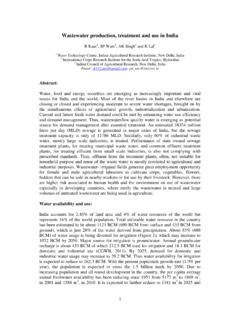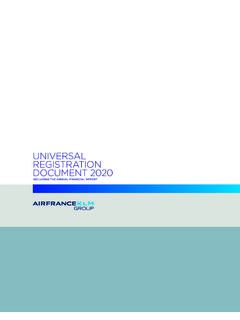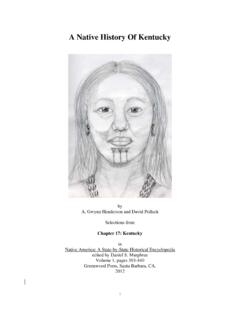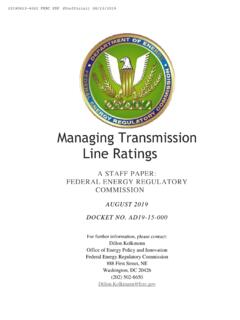Transcription of Drought conditions and management strategies in …
1 Drought conditions and management strategies in Zimbabwe S. S. Nangombe Meteorological Services Department, Harare, Zimbabwe, Background: Agriculture in Zimbabwe contributes to 19% of the country s GDP. Approximately 80% of Zimbabweans depend on this agriculture which is mostly rain fed for their livelihoods (Madzwamuse, 2010). Once, Zimbabwe was a food exporting nation with the country recording surpluses in food production almost every year. In recent years, the nation s crop production largely declined and one of the main contributing factors of this has been attributed to erratic and sub-normal rainfall amounts.
2 Over the past decade, the amount of rainfall the country receives has deviated from the multi-decadal mean on a regular basis (UNEP, 2010). On the later part of the 20th century, runoff in the country decreased by 20 to 30% (MMET, 1998). Of late, droughts have been crippling the nation and have contributed to the already low life-expectancy levels and high levels of emigration. During the Drought of the 1991/1992 season, for example, maize production decreased by almost 75 percent leaving a large percentage of the population in dire need of food aid.
3 The Grain Marketing Board (GMB) domestic maize intake during the 1992 Drought year was about 13 000 tonnes - just enough for two days consumption for the nation. Over one million head of cattle died of starvation during the year. Drought returned in 1993 and 1994 2002, 2004 and 2012 seasons which also affected livelihoods.. The 2012 Drought saw a deficit of approximately 45 per cent in the nation s staple food source, maize, (FDI Global Food and Water Security Research Programme, 2012).
4 About million Zimbabweans faced famine in 2012 (FDI Global Food and Water Security Research Programme, 2012). The cumulative occurrence of these droughts in rural Zimbabwe since 2002 has culminated in the stagnation of rural livelihoods which have enormously been agro-based. This deliberation has not only entrenched rural poverty, but, has seen the introduction of new strategies such as conservation farming and food handouts, all of which have failed to usher into a comprehensive remedy primarily because of the palliative nature of the 1.
5 droughts in Zimbabwe between 1950 and 2013 Grade Extreme Drought Severe Drought Mild Drought Flood/ Drought years 1983, 1992 1968, 1973, 1982, 2004 1951, 1960, 1964, 1965, 1970, 1984, 1987, 1991, 1995, 2002, 2003, 2005 , 2007, 2008, 2009, 2010 Total 2 4 16 Although the bulk of the Drought years were mild Drought , this also had an effect on the people s livelihoods, especially in rural areas. Fig 1: Time series showing the extreme rainfall years in Zimbabwe The last two decade 1990-2000 and 2000-2010 shown in figure 1 had more years in the Drought category than other decades.
6 Drought monitoring and early warning systems: Drought monitoring in Zimbabwe is carried out by two main ministries, the Ministry of Environment, Water and Climate through the Meteorological Services Department (MSD) and ministry of Agriculture through Agriculture Research and Extension Services (AGRITEX). The roles and responsibilities of the two organizations include systematic observation and monitoring of hydro-meteorological parameters; provision and publication of information, forecasts, products and services related to weather and climate.
7 Also these departments are responsible for the supply of data related to Drought -relevant parameters, indices and indicators. The early warning system for Drought in Zimbabwe at the national level is not very effective if not non-existent. This is the most overlooked area since so far there is no substantial establishment of a visible structure to that effect, yet it is the starting point for Drought preparedness. It follows that if there are effective monitoring and Drought forecasting, then adaptive capacity can be enhanced hence the management program becomes proactive rather than reactive.
8 It was only on paper but has not been put into practice. The Meteorological Services Department provides early warnings to the people for Drought from the time it starts disseminating the seasonal forecast. The seasonal forecast is generated by southern Africa regional climate experts together through the regional forum called the Southern Africa Regional Climate Outlook Forum and disseminated in August prior to the rainfall season. Each member state then downscale the regional forecast to their national level.
9 Then the Drought status is monitored as a continual process as the season progress hence this can pick out the intra-seasonal droughts that may have been missed by the seasonal forecast. The MSD uses the Standardised Precipitation Index which qualifies the severity of droughts in Drought monitoring. AGRITEX also does Drought monitoring by going further into getting the water requirement for the crops and livestock through the use of temperature, soil quality, evapotranspiration and rainfall.
10 They mainly use the Water Requirement Satisfaction Index (WRSI) in Drought monitoring. It is these two institutions who will advise the government on the country s Drought status and also are both members of the Zimbabwe s National Early Warning Unit (NEWU) which makes coordination and dissemination of information efficient. Vulnerability assessment: Zimbabwe s Drought vulnerability situation is represented every year through the Zimbabwe Vulnerability Assessment (ZIMVAC) report which outlines the vulnerability areas and groups.









